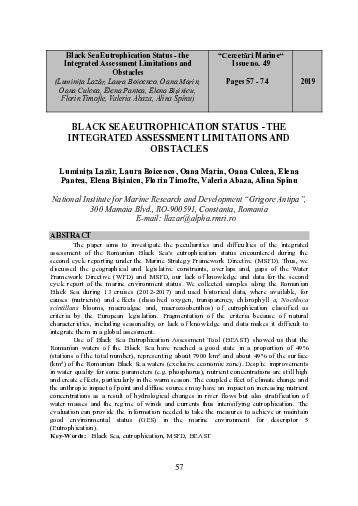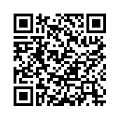Black Sea Eutrophication Status - the Integrated Assessment Limitations and Obstacles
DOI:
https://doi.org/10.55268/CM.2019.49.57Keywords:
Black Sea, eutrophication, MSFD, BEASTAbstract
The paper aims to investigate the peculiarities and difficulties of the integrated assessment of the Romanian Black Sea’s eutrophication status encountered during the second cycle reporting under the Marine Strategy Framework Directive (MSFD). Thus, we discussed the geographical and legislative constraints, overlaps and, gaps of the Water Framework Directive (WFD) and MSFD, our lack of knowledge and data for the second cycle report of the marine environment status. We collected samples along the Romanian Black Sea during 13 cruises (2012-2017) and used historical data, where available, for causes (nutrients) and effects (dissolved oxygen, transparency, chlorophyll a, Noctiluca scintillans blooms, macroalgae and, macrozoobenthos) of eutrophication classified as criteria by the European legislation. Fragmentation of the criteria because of natural characteristics, including seasonality, or lack of knowledge and data makes it difficult to integrate them in a global assessment. Use of Black Sea Eutrophication Assessment Tool (BEAST) showed us that the Romanian waters of the Black Sea have reached a good state in a proportion of 49% (stations of the total number), representing about 7900 km 2 and about 49% of the surface (km 2 ) of the Romanian Black Sea waters (exclusive economic zone). Despite improvements in water quality for some parameters (e.g. phosphorus), nutrient concentrations are still high and create effects, particularly in the warm season. The coupled effect of climate change and the anthropic impact of point and diffuse sources may have an impact on increasing nutrient concentrations as a result of hydrological changes in river flows but also stratification of water masses and the regime of winds and currents thus intensifying eutrophication. The evaluation can provide the information needed to take the measures to achieve or maintain good environmental status (GES) in the marine environment for descriptor 5 (Eutrophication).
Downloads
Published
2019-12-20
How to Cite
Lazăr, L., Boicenco, L., Marin, O., Culcea, O., Pantea, E., Bișinicu, E., Timofte, F., Abaza, V., & Spînu, A. (2019). Black Sea Eutrophication Status - the Integrated Assessment Limitations and Obstacles. Cercetări Marine - Recherches Marines, 49(1), 57–73. https://doi.org/10.55268/CM.2019.49.57
Issue
Section
ORIGINAL ARTICLES
License
This is an open access journal, which means that all content is freely available without charge to the user or his/her institution. Users are allowed to read, download, copy, distribute, print, search, or link to the full texts of the articles, or use them for any other lawful purpose, without asking prior permission from the publisher or the author. This is in accordance with the BOAI definition of open access.






